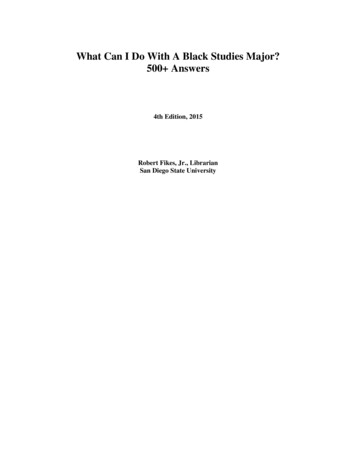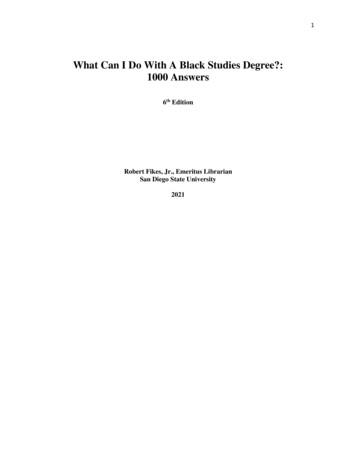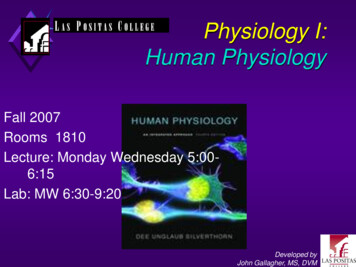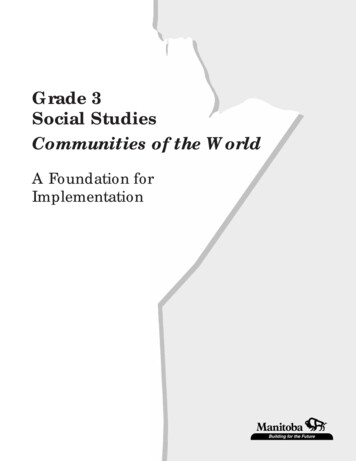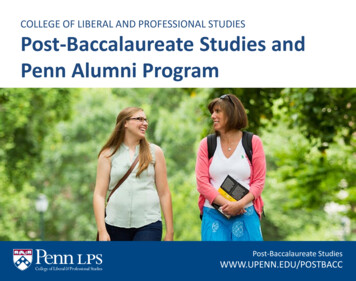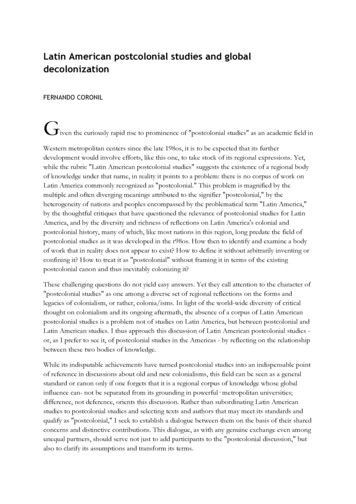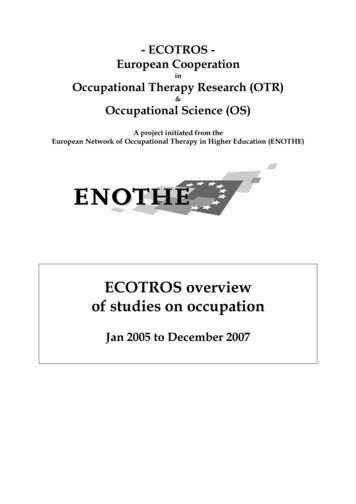
Transcription
- ECOTROS European CooperationinOccupational Therapy Research (OTR)&Occupational Science (OS)A project initiated from theEuropean Network of Occupational Therapy in Higher Education (ENOTHE)ECOTROS overviewof studies on occupationJan 2005 to December 2007
ECOTROS overview studies on occupationPage - 2 -ContentIn this ECOTROS-Information, you will find abstracts of current occupational science studies. The ECOTROS project group has identified the studies by simple search strategies at CINAHL and MEDLINE databases.Due to the ongoing debate on criteria for Occupational Science projects we have decided notto exclude particular abstracts. Thus the readers themselves may decide what is meaning- andhelpful for them. Please let us know what relevant abstracts of this period you are missing andsend them to sebastian.voigt@uniklinik-freiburg.de. They will be added.Since our overview is not comprehensive, we urgently recomend a complex and systematicsearch strategy in several databases and journals for specific research questions. Journals appropriate to search in for occupational science studies are as follows:American Journal of Occupational TherapyAustralian Occupational Therapy JournalBritish Journal of Occupational TherapyErgoscienceInternational Journal of Therapy and RehabilitationJournal of Occupational ScienceOccupational Therapy in Mental HealthOTJR: Occupation, Participation and HealthScandinavian Journal of Occupational TherapyAbstracts 2007Eakman A. Occupation and Social Complexity. [Journal Article] Journal of Occupational Science: Australia 2007 Jul;14(2):82-91.Applications of complexity science, including dynamic systems and chaos theories, have become ever-present in the social sciences. Diverse academic fields have begun to explore theircentral constructs from a complexity perspective. Occupational science has also begun to discover complexity science as an explanatory framework to aid in the study of occupation. Theoretical models, principles and empirical findings from a number of scholars of occupationsuggest that the tenets of complexity may serve an important role in explicating the nature ofoccupation. However, applications of complexity science in the field of occupational sciencehave almost exclusively focused on the system level of the human as a dynamic or chaoticsystem. In this article, I propose that the study of occupation should also be informed byadopting a social complexity perspective. This shift in analytic levels, in part, situates thestudy of occupation at the nexus of human-to-human interaction. Though a social level ofanalysis may restrict the attention given to any one individual, the resultant understanding ofthe manner by which individuals mutually influence each other via occupation would likelyextend our views of the form, function and meaning of human occupation.Dorne R. The power of occupation. [Journal Article, Anecdote, Pictorial] OT Practice. 2007Sep 10; 12(16): 17-22.
ECOTROS overview studies on occupationPage - 3 -Rachelle Dorne shares how she emphasized occupation-based interventions to help her daughter recover from a TBI.Rogers S. Occupation-based intervention in medical-based settings. [Journal Article, Forms,Review, Tables/Charts] OT Practice. 2007 Aug 27; 12(15): 10-6. (24 ref)Sandra Rogers describes how to overcome barriers to occupation-based practice, regardless ofthe setting.Participation and occupational performance in children -- developmental models and key concepts. [Journal Article, Abstract] Israeli Journal of Occupational Therapy. 2007 Aug; 16(3):E76.In the past, occupational therapists working with children based their intervention approacheson diverse disciplines such as neurophysiology, psychology or special education. In recentyears, as a consequence of the further establishment of occupational science, the number ofpublications concerning child development and functioning using the unique concepts of occupational therapy has increased. The first purpose of this article is to present to the Hebrewreader three theoretical models that relate to the development of occupational performance inchildren. In addition, the recent conceptual model of health, provided by the World HealthOrganization's International Classification of Functioning, Disability and Health (ICF) hasalso influenced and changed the theoretical and practical definitions of the profession of occupational therapy. Thus, the second purpose of this article is to present three additional models that were developed subsequent to these up-to-date constructs. These models emphasizethe factors that contribute to and affect the occupational performance and participation of typical and disabled children in all performance areas.Rosenblum S. Weintraub N. Learning disabilities and occupational therapy: review of research and practice as reflected in the IJOT. [Journal Article, Abstract, Review] Israeli Journal of Occupational Therapy. 2007 Aug; 16(3): E75-6.Occupational therapists work with individuals with learning disabilities (LD), who often havedifficulties in occupational performance. Most of the literature related to this population focuses on the effects of the learning disability on academic performance. In contrast, there is littleinformation relating to the impact the learning disability has on the daily lives of these individuals. Occupational therapists, whose work focuses on human occupation, understand theeffects of the learning disability on individuals' daily lives in the various areas of occupation.As a result, occupational therapists evaluate the occupational performance and participation indaily life of individuals with LD. In addition, occupational therapists assist individuals in coping with the impact of the disability on the various occupations in which they are involved,including, self care, social participation, play and leisure, work, as well as academic activities.The purpose of this review is to present articles describing Israeli occupational therapists' research and clinical work in the field of learning disabilities. These articles were published inthe IJOT in the past 15 years. The review does not include many studies by Israeli occupational therapists, which were published in the various journals abroad. This review serves as acomplementary document to the position paper relating to the Role of Occupational Therapists among Individuals with LD, which is published in this issue in Hebrew (and will be published in the next issue in English). The position paper, as well as the research and clinical
ECOTROS overview studies on occupationPage - 4 -work that are described in this review, reflect occupational therapists' understanding of thedifficulties with which individuals with LD cope on a daily basis. Both the position paper andthe review, reflect the professional view of occupational therapists of their role and contribution in this population. Within the review are embedded citations of adolescents, students andadults, who are coping with LD as well as their family members, describing their difficulties.The combination of these sources assists in demonstrating how the research and clinical workof the occupational therapists in Israel, during these years, focused on the needs of individualswho were interviewed and reflecting the implementation of the client centered approach. Inaddition, these sources assist in highlighting the areas in which more research and clinicalwork is still required.Greven C. Reflections from the heart. Occupation and the elderly. [Journal Article] OT Practice. 2007 Aug 13; 12(14): 40. (2 ref)Am J Occup Ther. 2007 May-Jun;61(3):290-302. Related Articles, LinksChronic pain and occupation: an exploration of the lived experience.Fisher GS, Emerson L, Firpo C, Ptak J, Wonn J, Bartolacci G.Occupational Therapy Department, College Misericordia, 301 Lake Street, Dallas, PA 18612,USA. gfisher@misericordia.eduOBJECTIVE: There is limited research on the relationship between chronic pain and occupation. This phenomenological research study explored the lived occupational experiences ofpeople who have chronic pain. METHOD: Via demographic questionnaires, semistructuredinterviews, and field notes, data were collected on 13 participants with various types of pain.RESULTS: Thematic analysis yielded one main theme: "Chronic Pain Is Life Changing." Thefollowing subthemes also emerged: "Chronic Pain Triggers Emotional Distress"; "ChronicPain Reveals the Strength of Relationships"; "Chronic Pain and Occupation Are ReciprocallyRelated Forces"; and "Chronic Pain Elicits Innovative Adaptive Responses." Study participants reported experiencing myriad troubling emotions; however, they resourcefully modifiedtheir routines and tasks and found enhanced meaning in favored occupations. CONCLUSIONS: This study illuminates the importance of therapeutic listening, the innovativeness ofpeople who have chronic pain, and the possible therapeutic potential of occupation.PMID: 17569386 [PubMed - in -------------------------------------Scand J Occup Ther. 2007;14(2):116-25. Related Articles, LinksParticipation in everyday occupations in a late phase of recovery after brain injury.Johansson U, Högberg H, Bernspång B.Department of Community Medicine and Rehabilitation, Occupational Therapy, Umeå University. Umeå. Sweden.
ECOTROS overview studies on occupationPage - 5 -The aim of this study was to describe to what extent individuals of working age, in a latephase after an acquired brain injury, participate in everyday occupations related to homemaintenance, work, and leisure. The aim was also to evaluate if participation in different occupations influences their life satisfaction. A sample of 157 people consecutively admitted toa rehabilitation clinic between June 1995 and December 2000 answered a mailed questionnaire. The subjects who were of working age had had a brain injury on average 6 years beforethis study. The perceived participation was reported using the Reintegration to Normal LivingIndex (RNL) and life satisfaction according to an expanded version of the LiSat 11. Thisstudy showed that in this late phase of recovery after brain injury the subjects still experiencedmany restrictions in participation in everyday occupations. The area with the lowest reportedparticipation was work activity while most comfort with the situation was reported for selfcare. The RNL subscales showed a significant connection with satisfaction with life as awhole. Furthermore an interaction was found between the two subscales "Daily living" and"Perception of self". This study showed restrictions in participation in the community evenseveral years after brain injury, which underlines the need for rehabilitation services long afterinjury.PMID: 17538856 [PubMed - in -------------------------------------Scand J Occup Ther. 2007;14(2):96-107. Related Articles, LinksOccupational patterns of people with dementia in residential care: An ethnographic study.Holthe T, Thorsen K, Josephsson S.Norwegian Centre for Dementia Research, Vestfold Mental Health Care Trust. Norway.This paper describes an ethnographic study that sought to gain knowledge of the occupationalpatterns of persons with dementia in a care home and how the residents perceived the groupactivities in which they participated. The residents' ages ranged from 82 to 92 years. Theywere seven women and one man. Both participant observation and interviews were used tocollect data. Data analysis resulted in an ethnographic story organised around two key themes:(1) the occupational patterns of the residents, and (2) the residents' perceptions of the activities offered. In this story residents appeared passive, playing the role of guests in the carehome. Residents were dependent on staff to engage in daily occupations. Interviews revealedthat residents perceived participation in activities as important to their mental and physicalhealth and an advantage of living in the care home.PMID: 17538854 [PubMed - in -------------------------------------Scand J Occup Ther. 2007;14(2):86-95. Related Articles, LinksThe influence of the environment on participation subsequent to rehabilitation as experiencedby elderly people in Norway.
ECOTROS overview studies on occupationPage - 6 -Vik K, Lilja M, Nygård L.Division of Occupational Therapy, Department of Neurobiology, Care Sciences and Society,Karolinska Institutet. Sweden.The aim of this study was to illuminate how the environment may influence participationamong elderly people who have undergone community-based rehabilitation in Norway, afteran acute illness or accident. Fourteen persons over 65 years of age were selected with the specific intention of gaining a variety of ages, both genders, and people living in different kindsof housing. Three focus groups were established and repeated interviews were held with eachgroup. A constant comparative analysis was used to analyse the data. The main finding wasthat the participants experienced pressure from their environment to concentrate on performing the most necessary daily activities rather than on participation. Three main encounterswith environments seemed to be important for this: encountering people and society, encountering private and formal assistance, and encountering occupation. The support that the participants received from family and friends was more important for their participation than havingaccessible physical environments. The findings suggest that occupational therapists must consider themselves to be part of a societal environment that can hinder participation.PMID: 17538853 [PubMed - in -------------------------------------Scand J Occup Ther. 2007;14(2):77-85. Related Articles, LinksVery old people's experience of occupational performance outside the home: Possibilities andlimitations.Hovbrandt P, Fridlund B, Carlsson G.Department of Health Sciences, Division of Occupational Therapy, Lund University. Sweden.To support occupations outside the home for older people with functional limitations it is important to understand how the person, environment, and occupations influence performance.Therefore the purpose of this study was to describe how very old people experience occupational performance outside the home. Twenty-one single-living, very old persons, above 80years, were strategically selected and interviewed. A phenomenographic approach was usedfor this study and the interviews were analyzed using contextual analysis. The findingsshowed a variation in the experience of occupational performance described in three referential aspects: keeping on doing as before, drawing on available resources, and living in constrained circumstances. Referring to everyday occupations the participants described how theycontinued to do what they had done before, but decline in functional capacity made it moredifficult to overcome environmental barriers. They also described how they sometimes couldput functional limitations aside and use their utmost capacity to reach their goals. When theycould not do that any more, they had to find possibilities for occupations close to home. Inorder to support very old people's occupational performance outside the home, outdoor mobility has to be facilitated, including the design of the physical environment as well as possibilities for social interaction.
ECOTROS overview studies on occupationPage - 7 -PMID: 17538852 [PubMed - in -------------------------------------Med J Aust. 2007 May 21;186(10):S67-9. Related Articles, LinksSpirituality as sustenance for mental health and meaningful doing: a case illustration.Wilding C.School of Community Health, Charles Sturt University, Albury, NSW, Australia. cwilding@csu.edu.au.In the past 10-20 years there has been increasing interest in the relationship between spirituality and health. I interviewed six patients from community mental health centres, using aphenomenological approach to explore how concepts of spirituality, occupation and mentalillness/mental health are related. One person's story is presented to illustrate the issues. Fourmain themes were identified: Spirituality is a phenomenon that provides meaning to life. Spirituality can help a person cope with mental illness. Spiritual beliefs can make everyday occupations more meaningful and health-enhancing. Some people find it valuable to engage inshared occupations that focus on spirituality. Spirituality is an important and relevant issue tobe discussed between patients and health practitioners, provided that practitioners can exercise sensitivity, caution, tolerance and acceptance of values that may differ from their own.PMID: 17516889 [PubMed - in -------------------------------------Can J Occup Ther. 2007 Apr;74(2):91-101. Related Articles, LinksDischarge decision-making, enabling occupations, and client-centred practice.Moats G.Rehab and Geriatrics Program, Deer Lodge Centre, Winnipeg, MB, Canada. jmoats@deerlodge.mb.caBACKGROUND: Occupational therapists working in hospitals are confronted with increasingly complex discharge decisions. However, the relationship of discharge-planning strategiesto the professional concepts of client-centred practice and enabling occupations has been unclear. PURPOSE: This study explored the relationship between the models of decisionmaking used by occupational therapists, and the professional issues of enabling occupationand client-centred practice. METHODS: Qualitative interviews were conducted with 10 occupational therapists. Data were analyzed for the presence and emergence of themes. RESULTS: Therapists try to balance the sometimes competing issues of safety and autonomy.Therapists often engage in negotiated decision-making. However, clients are sometimes excluded, despite therapists' commitment to client-centred processes. Consideration of occupations is often neglected. PRACTICE IMPLICATIONS: Client-defined models of decisionmaking are insufficient for frail, cognitively- impaired people. A new, client-centred Negoti-
ECOTROS overview studies on occupationPage - 8 -ated Model of Decision-Making is proposed, which facilitates decisions to enable older people with their occupations.PMID: 17458368 [PubMed - indexed for -------------------------------------Can J Occup Ther. 2007 Apr;74(2):78-90. Related Articles, LinksDefining spirituality and giving meaning to occupation: the perspective of communitydwelling older adults with autonomy loss.Griffith J, Caron CD, Desrosiers J, Thibeault R.Centre de santé et services sociaux La Pommeraie, Cowansville, Quebec. jgriffith@canoemail.comBACKGROUND: In the Canadian Model of Occupational Performance, meaningful occupation involves interaction between spirituality and environment. However little research existson the process of giving meaning to occupation. PURPOSE: This study explored both meaningful occupation and the definition of spirituality from the perspective of communitydwelling older adults with autonomy loss. METHOD: Using a qualitative approach, groundedtheory method of Glaser and Strauss (1967), eight cognitively intact persons were interviewedindividually. RESULTS: The process of giving meaning to occupation involves an intrinsiclink between identity and meaningful occupation, with identity being central to the person.Following autonomy loss, a process of adjusting identity, involving social, psychological andspiritual aspects, occurs over time. Spirituality is defined in terms of its close links to religionand belief in a benevolent greater power. IMPLICATIONS OF RESEARCH: This study contributes to the discussion of the concepts of spirituality, identity and meaning in occupationaltherapy.Publication Types:Research Support, Non-U.S. Gov'tPMID: 17458367 [PubMed - indexed for -------------------------------------Scand J Occup Ther. 2007;14(1):63-72. Related Articles, LinksInfluences of the social environment on engagement in occupations: the experience of personswith rheumatoid arthritis.Nyman A, Lund ML.Department of Health Sciences, Occupational Therapy, Luleå University of Technology, Luleå, Sweden. anneli.nyman@ltu.se
ECOTROS overview studies on occupationPage - 9 -The aim of this explorative study was to describe and enhance the understanding of how persons with rheumatoid arthritis (RA) experience the influence of the social environment ontheir engagement in occupations. Nine persons were interviewed and the data obtained wereanalysed using a comparative method. The findings revealed that other persons in the socialenvironment influenced informants' experiences of engaging in occupations in two ways,which formed the categories: "Constructive collaboration" and "Insufficient collaboration".These categories had certain properties related to the actions the others undertook to assist theinformants during their collaboration. These assisting actions influenced the informants' possibilities to engage in occupations, and also their experience of engagement. The findings alsoshowed that the "Conditions for collaboration" varied and influenced their collaboration,which thereby constituted a third category. The findings may contribute to a deeper understanding of how other persons can facilitate and restrict meaningful occupational experiences.This provides knowledge that can be used by occupational therapists when empowering theirclients and those close to them to reflect on their actions and the consequences of these actions to enhance occupational engagement.Publication Types:Research Support, Non-U.S. Gov'tPMID: 17366079 [PubMed - indexed for -------------------------------------J Gerontol Nurs. 2007 Feb;33(2):31-9. Related Articles, LinksDressing and grooming: preferences of community-dwelling older adults.Cohen-Mansfield J, Jensen B.Department of Health Promotion, Sackler Faculty of Medicine, Rockville, MD, USA. cohenmansfield@hebrew-home.orgThis study explored dressing and grooming habits and preferences of older adults. Fifty-eightcommunity-dwelling older persons (mean age 80 years) in suburban Maryland responded tothe Self-maintenance Habits and Preferences in Elderly (SHAPE) questionnaire. There was alarge variability in preferences, and all items were very important for at least some of the participants. Women attributed higher levels of importance to dressing and grooming than didmen. Importance ratings increased with level of education and were higher for unmarried persons, but were not related to age or need for assistance with instrumental activities of dailyliving (IADLs). On an individual basis, this information can be used to suggest items for interventions or to structure a personal care environment. Alternately, it can be used in the aggregate as a guideline for designing programs of care to reflect the preferences of a majorityof older persons.Publication Types:Research Support, Non-U.S. Gov'tPMID: 17310661 [PubMed - indexed for --------------------------------------
ECOTROS overview studies on occupationPage - 10 -Am J Occup Ther. 2007 Jan-Feb;61(1):9-20. Related Articles, LinksEveryday occupation, well-being, and identity: the experience of caregivers in families withdementia.Hasselkus BR, Murray BJ.Occupational Therapy Program, University of Wisconsin-Madison, 1300 University Avenue,Madison, WI 53706, USA. bh@education.wisc.eduThe purpose of this study was to gain understanding of the nature of the daily occupations ofcaregivers for family members with dementia as related to the caregivers' perceptions of wellbeing. Qualitative telephone interviews, focused on the experience of caregiving, were conducted with 33 caregiver-respondents; the data were transcribed and analyzed using a phenomenological approach. Everyday occupation emerged as a phenomenon that was central tothe caregivers' ways of evaluating and monitoring well-being in the care receivers and themselves. Further, occupational engagement served to help mitigate the potential biographicaldisruption of the dementia caregiving experience. The implications for occupational therapypersonnel are convincing: Everyday occupation holds promise for contributing to the relativewell-being of both caregivers and care receivers and for facilitating continuity of relationshipsand identity for the caregiver.Publication Types:Research Support, Non-U.S. Gov'tPMID: 17302101 [PubMed - indexed for MEDLINE]
ECOTROS overview studies on occupationPage - 11 -Abstracts 2006 1 Accession Number2009265342.Special Fields ContainedFields available in this record: abstract, cited references.AuthorHaggblom-Kronlof G. Sonn U.TitleInterests that occupy 86-year-old persons living at home: associations with functional ability,self-rated health and sociodemographic characteristics.SourceAustralian Occupational Therapy Journal. 2006 Sep; 53(3): 196-204. (34 ref)Abbreviated SourceAUST OCCUP THER J. 2006 Sep; 53(3): 196-204. (34 ref)AbstractBackground and Aims: Interest is generated from the experience of pleasure in occupationalbehaviour. However, there is little known about the type and amount of interests that occupyvery old people. The aims of the present study were to explore the interests of people aged 86years who are living at home (n 205) and to study the association between these interestsand functional ability, self-rated health and sociodemographic characteristics. Methods: Participants were interviewed during home visits and data were analysed by using content analysis and statistics. Results: Participants had a broad range of interests. Personal and environmental factors played a part in people giving up their interests. Participants who regarded theirhealth as good or who had no problems in carrying out daily activities had more interests thanthose with poor health or limited ability to participate in daily activities. Few differencesbased on gender and sociodemographics were found. Conclusions: Being active (i.e. practising many interests) also means experiencing good health. In the name of occupational justice, it is important to enable elderly persons to pursue interests. 2 Accession Number2009242333.Special Fields ContainedFields available in this record: abstract, cited references.AuthorDouglas FM.TitleOccupational balance: the relationship between daily occupations and wellbeing.SourceInternational Journal of Therapy and Rehabilitation. 2006 Jul; 13(7): 298. (8 ref)Abbreviated SourceINT J THER REHABIL. 2006 Jul; 13(7): 298. (8 ref)AbstractFiona M Douglas addresses the concept of individuals as 'occupational beings' with a need tomaintain a balance between competing occupations in day-to-day living.
ECOTROS overview studies on occupationPage - 12 - 3 Accession Number2009207572 NLM Unique Identifier: 16776393.Special Fields ContainedFields available in this record: abstract, cited references.AuthorHumphry R. Wakeford L.InstitutionProfessor, University of North Carolina at Chapel Hill, Division of Occupational Science,CB #7120, Chapel Hill, NC 27599-7120.TitleAn occupation-centered discussion of development and implications for practice.SourceAmerican Journal of Occupational Therapy. 2006 May-Jun; 60(3): 258-67. (58 ref)Abbreviated SourceAM J OCCUP THER. 2006 May-Jun; 60(3): 258-67. (58 ref)AbstractChildren's learning to do everyday activities seems so obvious that the mechanisms bringingabout the development of occupations remain essentially unstudied. Therefore, occupationaltherapy uses developmental models from other disciplines as foundation for practice. We specialists in childhood occupations need a theory-based and empirically tested body ofknowledge about the processes leading to change to inform practice and guide interventionsduring efficacy studies. One body of knowledge about developmental mechanisms viewschange as originating from within the child and informs practice centered on changing thechild. Given the inseparable nature of children and their social environments and daily activities, we introduce the philosophy of contextualism and outline a potential body of knowledgeabout a change process that is occupation centered. An intervention arising from a contextualperspective illustrates how this way of thinking leads to occupation-centered practice that usesmultiple strategies and supports a child's occupation with social participation with peers. 4 Accession Number2009274461.Special Fields ContainedFields available in this record: abstract, cited references.AuthorArmstrong A. Blair SEE.TitleChange and continuity: retrospective thoughts about the protective and sustaining nature of ameaningful occupation.SourceMental Health Occupational Therapy. 2006 Jul; 11(2): 41-3. (24 ref)Abbreviated SourceMENT HEALTH OCCUP THER. 2006 Jul; 11(2): 41-3. (24 ref)AbstractOccupation is multifaceted and ubiquitous. In this article, the value and importance of onevalued occupation is explored in retrospect by the first author. At times of change and transition, adaptation can be accompanied and facilitated by occupations, which may protect andsustain the individual through the period of discontinuity. In this situation, a granddaughterreflects upon the powerfulness of poetry as an occupation which protected her grandmother's
ECOTROS overview studies on occupationPage - 13 -transition from independent living to becoming part of her own daughter's family. The impactupon her grandchildren was considerable. The poetry books acted as transitional objects, butin addition, reading, recitations and the associations that the chosen poems had, se
Occupational Therapy Department, College Misericordia, 301 Lake Street, Dallas, PA 18612, USA. gfisher@misericordia.edu OBJECTIVE: There is limited research on the relationship between chronic pain and occupa-tion. This phenomenological research study explored the lived occupational experiences of
